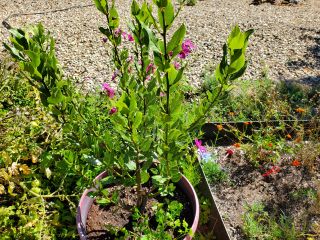

Many culinary herbs also have medicinal properties.
Key points
- Most herbs are easily grown and will come back every spring.
- Garden sage and bay leaves are commonly used as culinary herbs, but both also have medicinal properties.
- Seasoning with herbs can add a great flavor to your meals.
In an article from earlier this year, I described the strong medicinal properties of the two common culinary herbs: rosemary and cilantro. Today, I want to direct my readers’ attention to the two other herbs commonly used for cooking which also have strong medicinal properties: garden sage and bay leaf, which is also called laurel leaf.
Garden Sage
Garden sage (salvia officials), also called common sage, is a perennial herb that grows over winter in southern parts of the country; therefore, it can be used fresh for cooking all year long. It is a member of the mint family (Lamiaceae). It is drought tolerant and can survive hot summers and periods of little watering. The leaves and flowers have a nice smell and can also be used in natural bouquets and dry arrangements. Garden sage also repels bed bugs in your garden.
Garden sage is most commonly used in turkey dishes for Thanksgiving, but it also goes very well with chicken, pork, and fish dishes. I add this versatile herb to most of my soups, sauces (i.e., home-made tomato pasta sauce), and stews.
Garden sage is rich in vitamin and minerals and low in calories. It contains vitamin K, B6, A, C, and E. As for minerals, it contains iron, calcium, manganese, magnesium, zinc, and copper.
It has potent medicinal properties and has been used in folk medicines for centuries. Its anti-inflammatory properties have been used to treat sore mouths and throats. Some research suggests that it can help with memory loss, diabetes, and high cholesterol.
I have been familiar with this herb since my childhood. My mother use to make a tea out of it if I had a sore throat or gum pain, and it was helpful.
Bay Leaf

Image by Barbara Koltuska-Haskin
Bay leaf, also called a Lauer leaf, is an aromatic leaf from a tree or a shrub (Laurus nobilis) native to the Mediterranean region. It grows very well in a pot (see mine in the picture), but it is not frost tolerant; it needs to be brought inside during winter, kept close to a sunny window, and watered regularly (once a week).
Lauer (bay) leaves were the earliest and most widely traded spices, used in many cuisines around the world. In ancient Greek and Rome, Lauer wreath was given to important people and leaders and worn as a symbol of triumph.
Laurel (bay) leaves are very commonly used nowadays as a culinary herb. They can be used fresh or dried in a variety of dishes, soups, stews, and fish dishes. They can also be used in risotto, pasta sauces, dried beans dishes, or you can just sprinkle crushed leaves over your favorite salad. Bay leaves have a potent flavor, so only a few leaves should be used in dishes.
Bay leaves contains vitamin A, C, and B6 and minerals such as calcium, iron, and manganese and have been used as a medicinal plant since ancient times. They have anti-inflammatory, antioxidant, and antifungal properties. They can also be used to help reduce stress and anxiety. Some studies suggest that bay leaves may help lower blood sugar, reduce cholesterol, and possibly protect against heart disease.
Seasoning with fresh herbs is easy and makes your food much tastier and healthier. You don’t need to make any heavy sauces. Just add fresh herbs to your dish while cooking. If you don’t have a yard, then grow herbs in small containers on the windowsill. Most of the culinary and medicinal herbs are easily grown, care-free and will come back every spring. You only need to add sun and water. Fresh herbs are very potent, and you don’t need a lot of them to make your favorite dish taste great. I use them all the time in my kitchen.
About the Author
 Barbara Koltuska-Haskin, Ph.D., is a neuropsychologist in private practice in Albuquerque, New Mexico with over 30 years of clinical experience, and the author of How My Brain Works: A Guide to Understanding It Better and Keeping It Healthy. Her book has won 2 International Book Awards and 5 National Book Awards.
Barbara Koltuska-Haskin, Ph.D., is a neuropsychologist in private practice in Albuquerque, New Mexico with over 30 years of clinical experience, and the author of How My Brain Works: A Guide to Understanding It Better and Keeping It Healthy. Her book has won 2 International Book Awards and 5 National Book Awards.
 Dr. Barbara Koltuska-Haskin has received her first foreign translation. How My Brain Works was recently translated into Polish and published in Poland.
Dr. Barbara Koltuska-Haskin has received her first foreign translation. How My Brain Works was recently translated into Polish and published in Poland.







Comments
Post a Comment